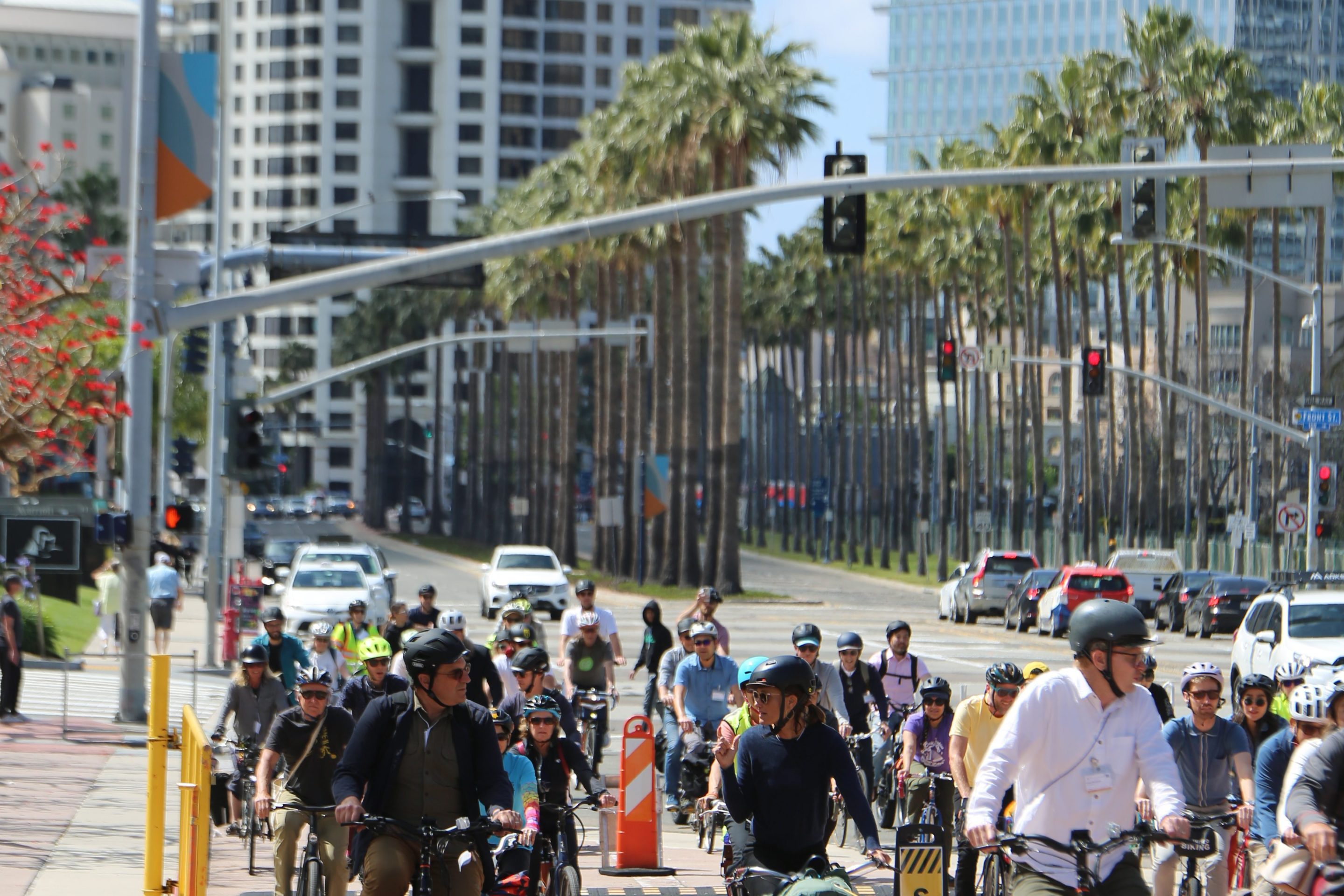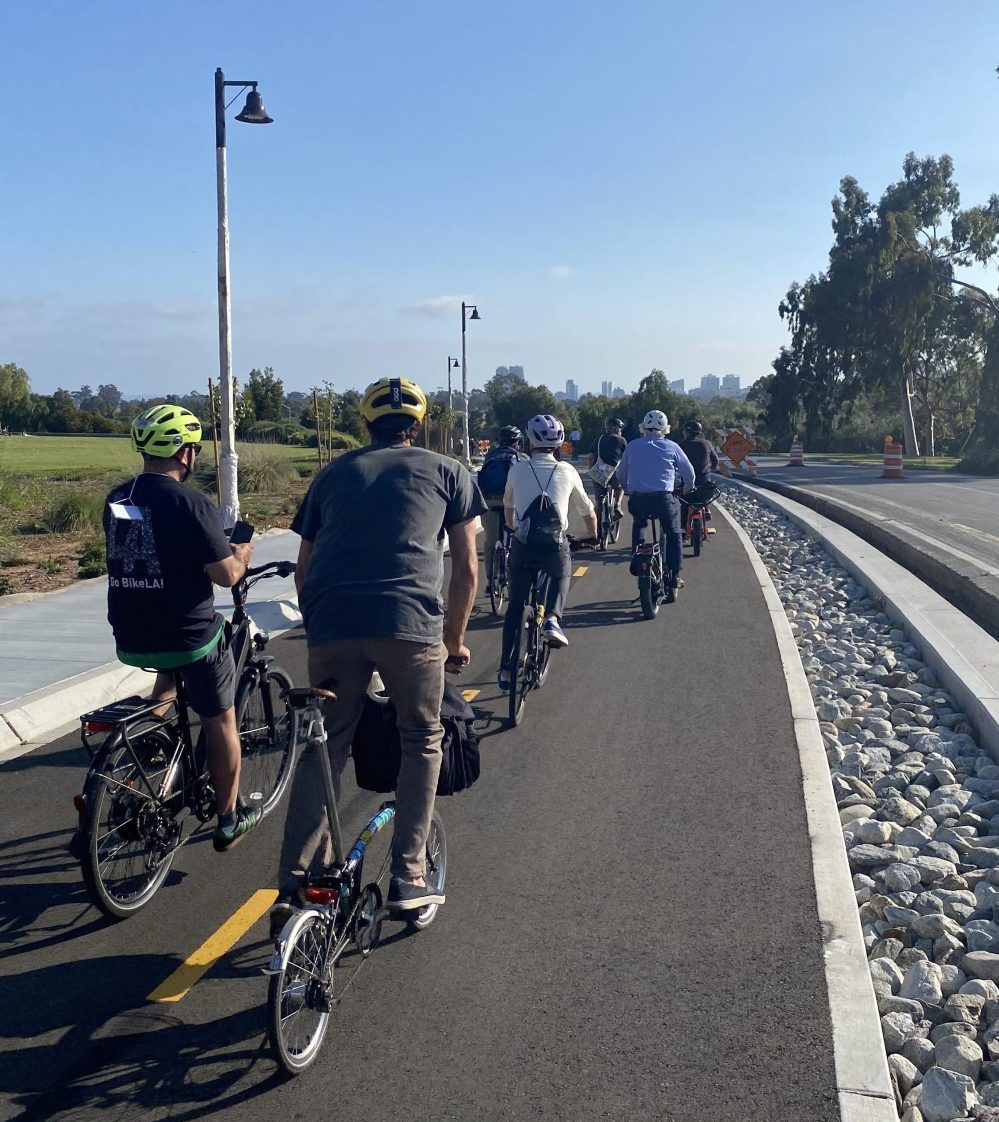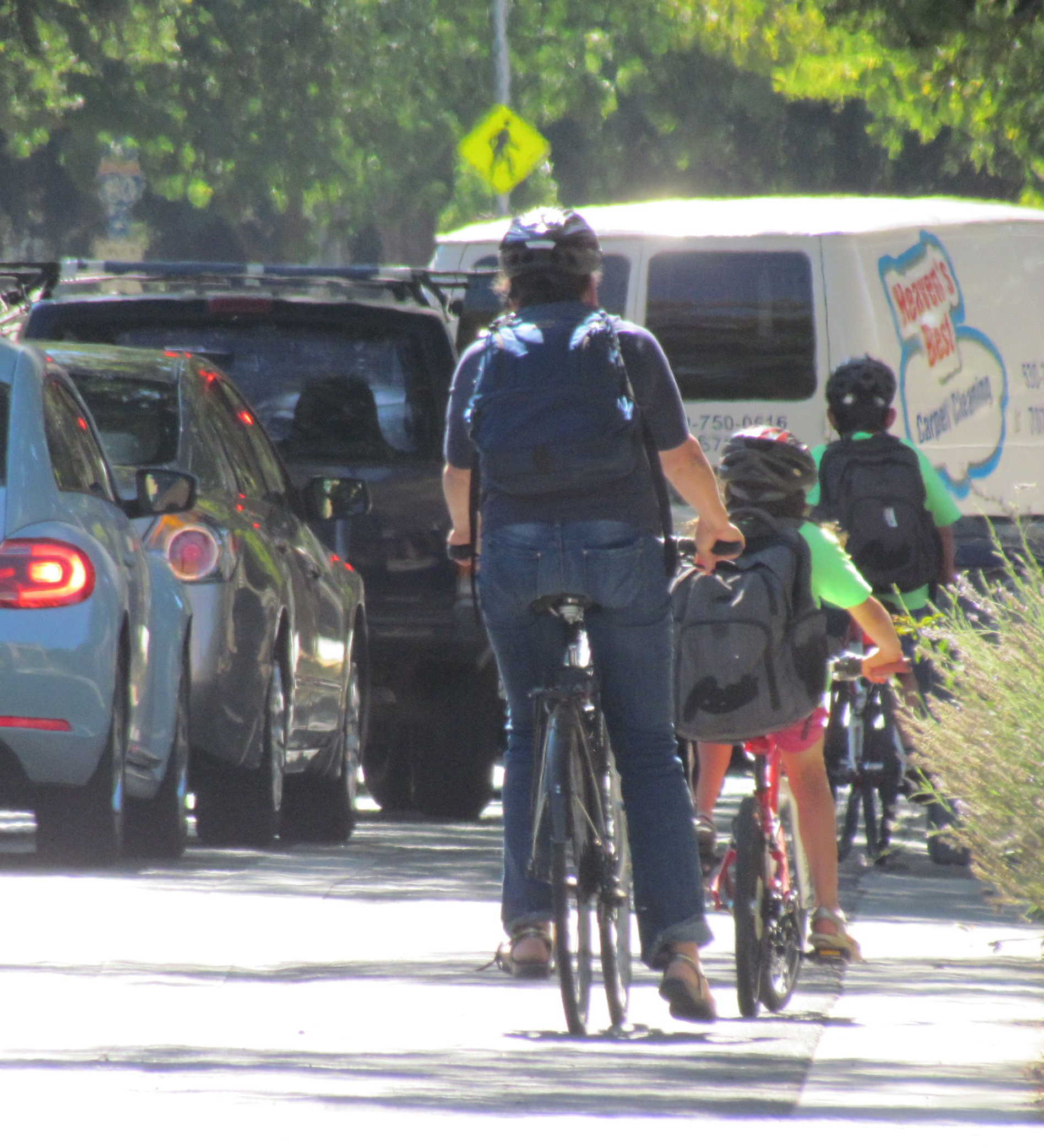Transportation Commission: Touting Active Transportation, Approving Highway Expansions
Despite public pleas to stop spending on highway expansion, pro-expansion forces still take the day.
5:01 PM PDT on March 27, 2024
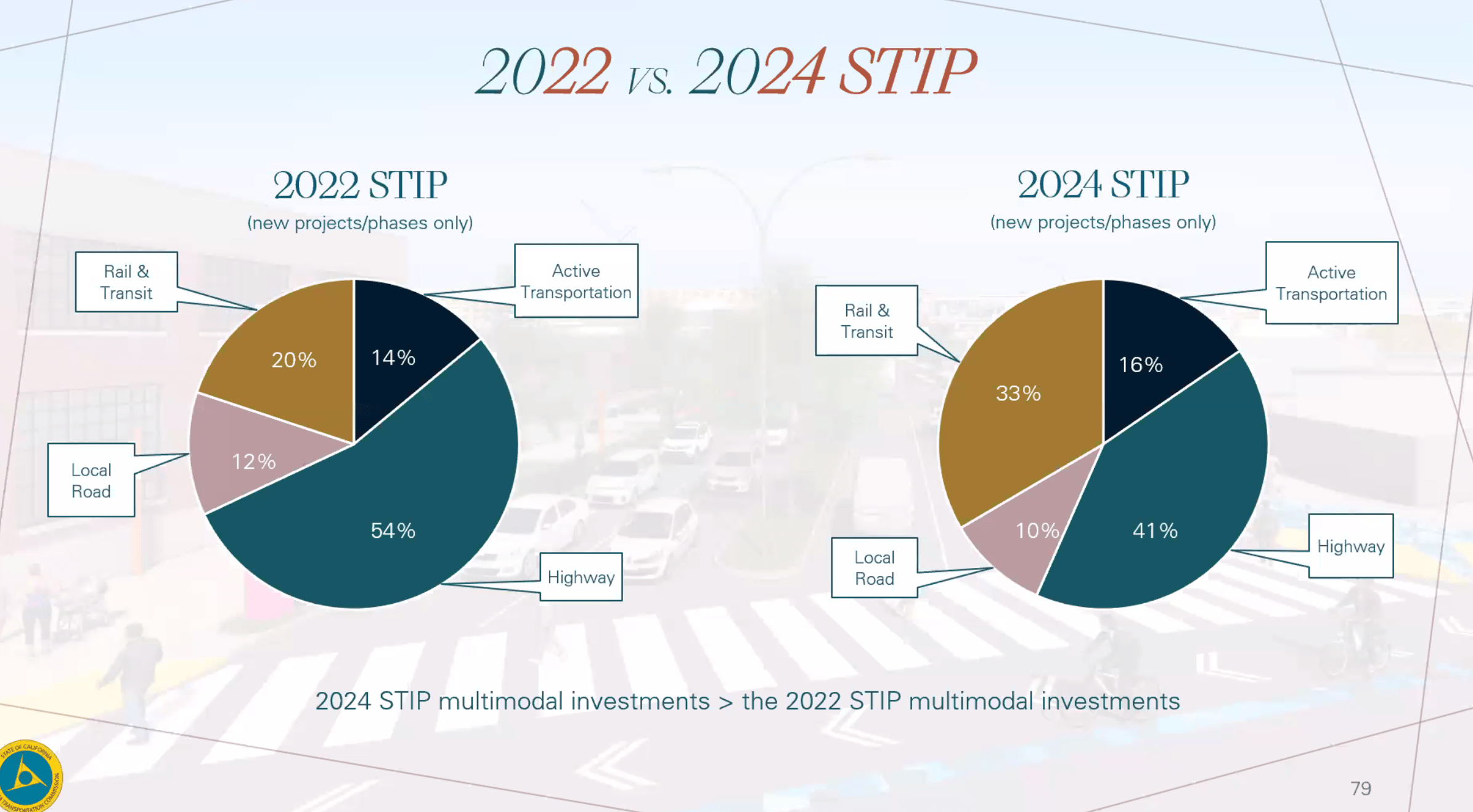
Multimodal investments in STIP are increasing over time. Image: Caltrans
Note: GJEL Accident Attorneys regularly sponsors coverage on Streetsblog San Francisco and Streetsblog California. Unless noted in the story, GJEL Accident Attorneys is not consulted for the content or editorial direction of the sponsored content.
First things first: at the last minute, the California Transportation Commission (CTC) rescheduled its discussion of the controversial Yolo Causeway project, which is a plan to widen I-80 between Davis and Sacramento. The delay was apparently in response to a letter sent to the commission by the California Air Resources Board outlining serious flaws in the environmental documents for the project.
But the letter was not very different from one Caltrans already had from CARB in response to the draft EIR. Was the delay because the commissioners or their staff hadn't seen it? Or did sending it directly to the CTC mean they couldn't ignore it? CTC Chair Carl Guardino gave no reason for the rescheduling.
But a lot of other things happened at last week's epic two-day meeting. The CTC:
- Adopted the 2024 State Highway Operations and Protection Program (SHOPP), a four-year, $21 billion list of locally prioritized state highway projects. According to Caltrans Chief Deputy Director Mike Keever, the 2024 SHOPP is the first one based on the Climate Action Plan for Transportation Investments (CAPTI), and it includes adjustments made to the "pipeline" of projects to align them with that state plan. It also contains "nearly $1 billion" in bike and pedestrian projects, he said. That includes 250 miles of new bike lanes (but of what quality? More about that below).
- Adopted the State Transportation Improvement Plan (STIP), which allocates close to $3 billion for locally prioritized highway, road, transit, and active transportation projects. The presentation highlighted transit and rail improvements, and CTC Executive Director Tanisha Taylor said that "about half of the STIP" would go for rail, transit, and active transportation. But the numbers seem to differ: The documents show $677 million for "multimodal" improvements out of a total of $2.9 billion – that seems closer to a bit less than a quarter, rather than a half.
- Approved funding for controversial highway expansions/interchanges on Hwy 99 in Fresno and Tulare, and for a controversial plan to add auxiliary lanes (widen) Highway 1 in Santa Cruz. The project in Fresno, like the I-80 Yolo Causeway project, is being litigated over its controversial methodology in its estimates of induced traffic, among other concerns.
- Approved the sale of one property along the cancelled 710 stub in South Pasadena, amidst passionate pleas from current residents who are facing eviction from Caltrans-owned property and after one person was injured during a protest over one of those evictions
- Approved guidelines for the Active Transportation Program, and got an update on estimated funds for the ATP. Currently, it has about $100 million for the first two years of the coming cycle, and over $180 million in the last two. However, since Governor Newsom's plan to balance the budget includes a plan to cut ATP funding, that may change by June.
- Heard an update on the Caltrans System Investment Strategy, which is attempting to align transportation planning with climate policies. The draft CSIS is currently accepting public comment, through April 15, with a final draft expected on June 30.
A Slowly Changing Focus - Maybe
Notable last week was the continuation of a slow shift in what gets highlighted at CTC meetings. Executive Director Taylor noted that the state is "entering an exciting period of investments in righting historic wrongs" at the beginning of the meeting. Presentations on highway projects celebrated the active transportation elements that they included. The Caltrans Chief Deputy Director Mike Keever's opening presentation honored several Caltrans employees who are "passionate" about promoting bicycle and pedestrian safety (including District 4 Chief of Transit and Active Transportation Sergio Ruiz).
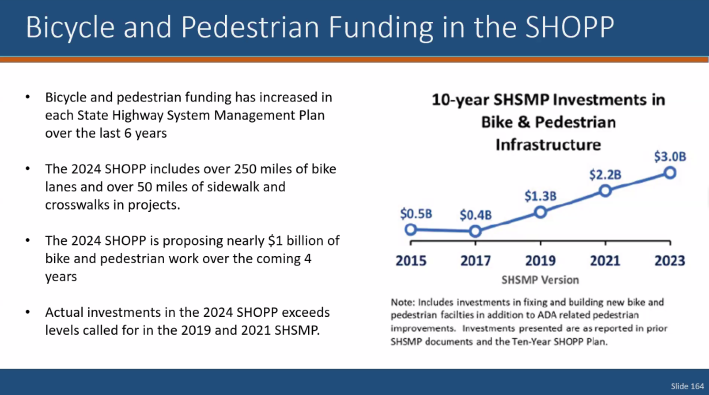
Meanwhile, resistance to shifting transportation funding towards sustainable modes remains stiff, with supporters of highway expansion developing and shifting their arguments in the face of growing concern about climate change. This ranged from a labor leaders calling in to say "our members do not use bike lanes or rail" to Kiana Valentine of Transportation California insisting the state must continue expanding highways. Not surprising, as Valentine is the same person who pushed hard against including any call for reducing driving in CAPTI, at the time saying that it would be economically devastating. "In my world view, strategic highway investments are helping solve climate," she said, "by mitigation measures and investments in active transportation and transit."
This is painfully and patently untrue. While state and local agencies have begun to grapple with mitigation, they are far from understanding how and how much their suggested measures would make up for increases in vehicle travel. And that's without mentioning their paltry numbers or whether they will happen at all, even if they are included in planning documents. Meanwhile the highway expansion projects they are supposed to mitigate are moving ahead.
Public Testimony Is Important, but Not Convincing
Notable, too, is what seems to be an increase in public participation at these meetings. This may be because the state's efforts at transparency are starting to bear fruit. For example, those multimodal projects, and even portions of projects, are broken out in the STIP; the SHOPP, meanwhile, has debuted a new publicly-accessible dashboard showing where money is being spent and for what.
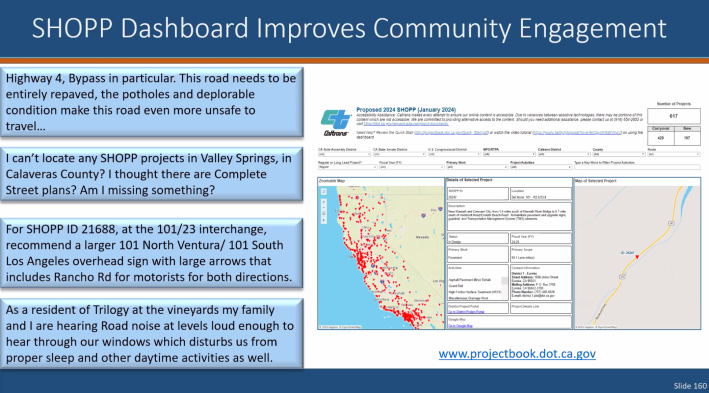
Getting people to weigh in on projects and plans that affect them also takes a fair amount of organizing on the part of advocacy groups. Last week, multiple people called in on the same line to give personal testimony (these were in opposition to the freeway expansions in Fresno and Tulare). The commissioners listened, acknowledged some of the concerns people brought up, and even took some city planners to task for what seemed preemptive dismissal of that public testimony. The commissioners seem sensitive to accusations that they are no more than a "rubber-stamping agency," with several of them specifically denying it from the dais. But in the end they approved all the projects brought before them, following the guidance of their staff, of the "expert" planners and engineers, and of Executive Director Taylor, who reminded them several times that their legal jurisdiction and decision-making powers are limited.
Other exchanges were revealing. For example, the planners working on the Highway 99 interchange at American Avenue in Fresno County had said that bike lanes were part of the project, but when Commissioner Darnell Grisby asked them what type of bike lanes, they didn't know. When they came back a few minutes later with the answer, it was Class III. Caltrans District 6 Director Diana Gomez described them as "separated, but not with barriers," but that's not at all what Class III bike lanes are. Basically not much more than marked routes, sometimes with sharrows, Class III lanes are pretty much useless. And putting them on roads where many large trucks are moving through, which this project seems to be planning to do, is a ridiculous and dangerous exercise in box-checking.
This is a warning to take every presentation that celebrates "adding bike lanes" to a highway project with a very healthy dose of salt. It also is a reminder of just how much more work needs to be done at the ground level on individual projects if any of these giant road projects are actually going to benefit people outside of cars.
Commissioner Grisby quietly reminded planners that "when we [present] a project, we should have information about the multimodal side, not just the highway side." He then had to ask the same question about a Highway 99 expansion in Tulare the following day, so maybe no one was listening.
At another point in the meeting, State Asset Management Engineer Michael Johnson said Caltrans had received many public comments on the SHOPP. "By far we received more comments on bike and pedestrian concerns than anything else," he said.
Does that mean these are important concerns that should be taken seriously? Apparently not.
"The community is very organized," he said. "That is why, numbers-wise, 35 of the comments have identical text. We have to take that into consideration."
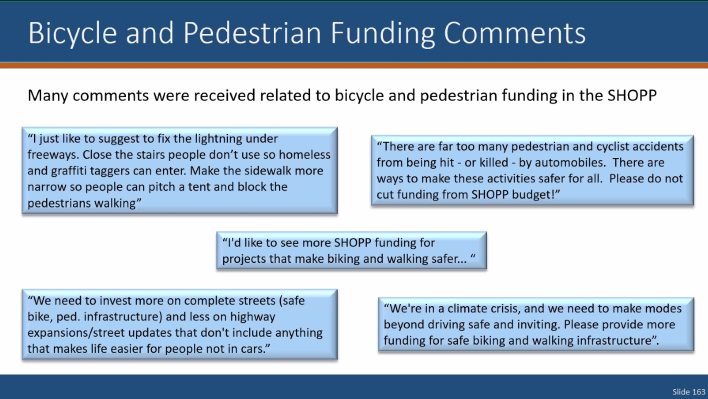
Commissioner Adonia Lugo didn't let that pass. "I know maybe a little too much about the field of active transportation advocacy," she said. For many years, bike advocacy "has been characterized by leadership of white men," she acknowledged. "But there's been a lot of work to expand who we are including in our strategy."
"For those of us who are early adopters [of active transportation], it's clear to us that the need for these projects is not a special interest," she said. Advocates don't push for safe routes "so that people who like riding bikes can do it more. It's so that people who are vulnerable can be safe from harm. The reason we push for inclusion is not because people love wearing spandex and gettin' out there on the weekend. When we are working for across-the-board inclusion of compete streets, it's for everybody, including for the people who are not going to make their way into this [advocacy] space, who are not even going to cut and paste" a note to send to Caltrans.
"No doubt about it, that the movement has taken a combative stance. We just passed a ballot measure in L.A. that says suing the city is the best way to get safe infrastructure," she said. "We'll see how that works. I absolutely understand how people see bike advocacy as a special interest. But we have to let that go."
Streetsblog California editor Melanie Curry has been thinking about transportation, and how to improve conditions for bicyclists, ever since commuting to school by bike long before bike lanes were a thing. She was Managing Editor at the East Bay Express, editor of Access Magazine for the University of California Transportation Center, and earned her Masters in City Planning from UC Berkeley.
Stay in touch
Sign up for our free newsletter
More from Streetsblog California
Metro Board Funds Free Student Transit Pass Program through July 2025
Metro student free passes funded another year - plus other updates from today's Metro board meeting
Commentary: There is Zero Ambiguity to the West Portal Tragedy
What happened in West Portal was entirely predictable and preventable. The city must now close Ulloa to through traffic and make sure it can never happen again
Friday’s Headlines
Inspiration from the Bike Summit; OakDOT proposes standards for temporary safety upgrades; San Diego transforms a fast road in Balboa Park; Stockton transit funding is under threat; More
Active Transportation Program Calls for Volunteer Evaluators
Apply to be a volunteer ATP application evaluator by May 10.
